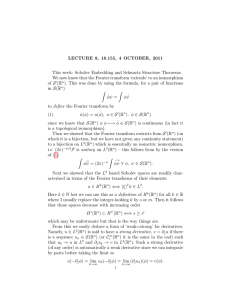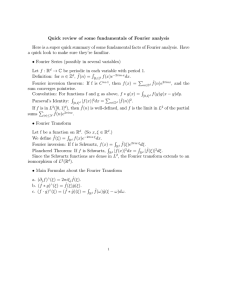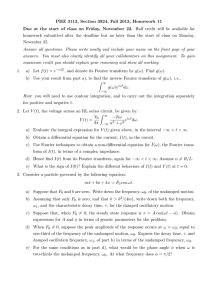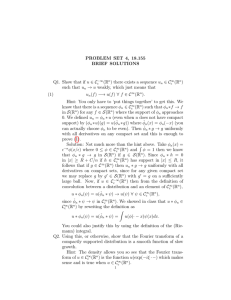18.155 LECTURE 3: 12 SEPTEMBER, 2013 ) −→ S(R
advertisement
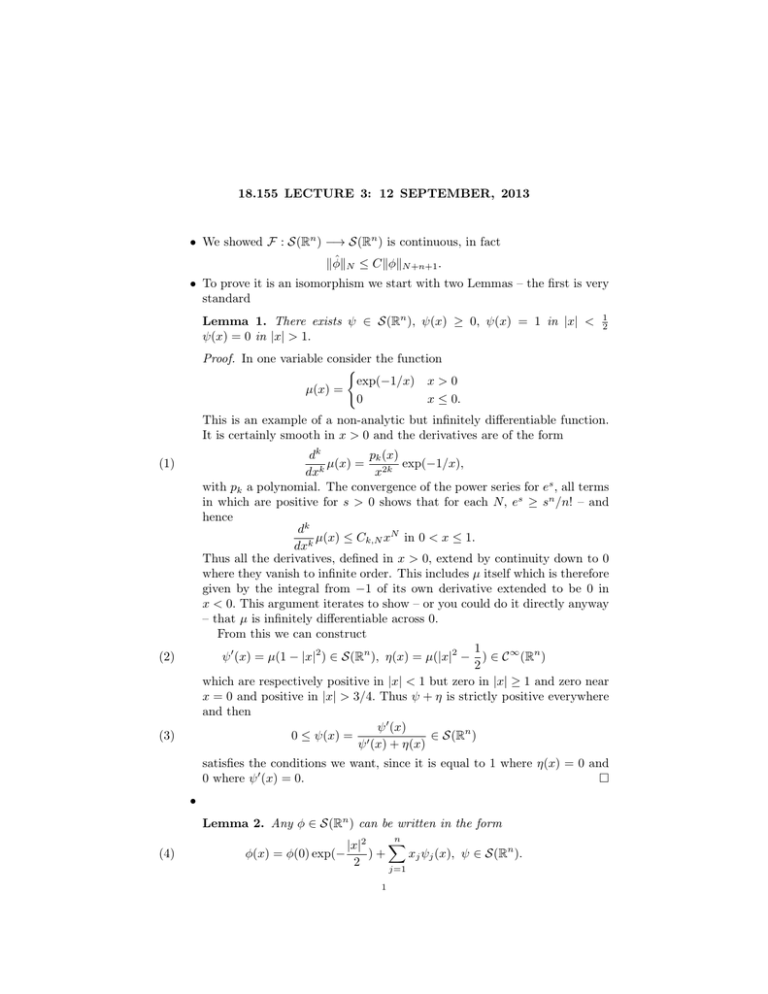
18.155 LECTURE 3: 12 SEPTEMBER, 2013
• We showed F : S(Rn ) −→ S(Rn ) is continuous, in fact
kφ̂kN ≤ CkφkN +n+1 .
• To prove it is an isomorphism we start with two Lemmas – the first is very
standard
Lemma 1. There exists ψ ∈ S(Rn ), ψ(x) ≥ 0, ψ(x) = 1 in |x| <
ψ(x) = 0 in |x| > 1.
1
2
Proof. In one variable consider the function
(
exp(−1/x) x > 0
µ(x) =
0
x ≤ 0.
This is an example of a non-analytic but infinitely differentiable function.
It is certainly smooth in x > 0 and the derivatives are of the form
dk
pk (x)
µ(x) = 2k exp(−1/x),
dxk
x
with pk a polynomial. The convergence of the power series for es , all terms
in which are positive for s > 0 shows that for each N, es ≥ sn /n! – and
hence
dk
µ(x) ≤ Ck,N xN in 0 < x ≤ 1.
dxk
Thus all the derivatives, defined in x > 0, extend by continuity down to 0
where they vanish to infinite order. This includes µ itself which is therefore
given by the integral from −1 of its own derivative extended to be 0 in
x < 0. This argument iterates to show – or you could do it directly anyway
– that µ is infinitely differentiable across 0.
From this we can construct
1
ψ 0 (x) = µ(1 − |x|2 ) ∈ S(Rn ), η(x) = µ(|x|2 − ) ∈ C ∞ (Rn )
2
which are respectively positive in |x| < 1 but zero in |x| ≥ 1 and zero near
x = 0 and positive in |x| > 3/4. Thus ψ + η is strictly positive everywhere
and then
ψ 0 (x)
∈ S(Rn )
0 ≤ ψ(x) = 0
ψ (x) + η(x)
(1)
(2)
(3)
satisfies the conditions we want, since it is equal to 1 where η(x) = 0 and
0 where ψ 0 (x) = 0.
•
(4)
Lemma 2. Any φ ∈ S(Rn ) can be written in the form
n
X
|x|2
φ(x) = φ(0) exp(−
)+
xj ψj (x), ψ ∈ S(Rn ).
2
j=1
1
2
18.155 LECTURE 3: 12 SEPTEMBER, 2013
Proof. Taylor’s formula and then use of the cutoff from the previous lemma.
• Now, to back to the Forier transform. We consider the composite and then
restrict to 0 and claim that
G(φ̂)(0) = cφ(0) ∀ φ ∈ S(Rn )
(5)
(6)
(7)
where c is a fixed constant independent of φ. Indeed to see this insert (4)
into the left side to get
X
|x|2
G(φ̂)(0) = cφ(0) +
G(x[
).
j ψj )(0), c = G(γ̂)(0), γ = exp(−
2
j
However, x[
j ψj (ξ) = i∂ξj ψ̂j (ξ) as we showed last time and since
Z
G(f )(0) = (2π)−n f,
so each of the terms in the sum vanishes. Thus we arrive at (5) where we
even no the constant in terms of the Gaussian.
• Now, we can also work out formulæ for the Fourier transform of translates
and multiples by exponentials:-
(8)
F(φ(• + y))(ξ) = eiy·ξ ψ̂, G(e−iy·• f )(x) = G(f )(x + y).
Combining these two and (5) shows that
GF = c Id .
(9)
• So we are reduced to working out the constant. This amounts to working
out the Fourier transform of the Gaussian and this is pretty standard. First
we only need do the 1-D case since
Y
|x|2
)=
F(exp(−x2j /2)
(10)
F(exp(−
2
j
(11)
(12)
and then we can check that
d
( + ξ)F(exp(−x2 /2)(ξ) = 0 =⇒ F(exp(−x2 /2)(ξ) = c0 exp(−ξ 2 /2)
dξ
where the constant is the value of the Fourier transform at 0, i.e.
Z
√
c0 exp(−x2 /2) = 2π.
R
Going back to (5) it follows that c = 1 and we have the Fourier inversion
formula
G ◦ F = Id = F ◦ G on S(Rn )
(13)
where the second follows from the first by changing signs.
• So the Fourier transform is an isomorphism on S(Rn ), a continuous linear
bijection with a continuous inverse.
• Computing with absolutely convergent Lebesgue integrals it also follows
directly that for any φ, ψ ∈ S(Rn ),
Z
Z
Z
−ix·ξ
(14)
φ̂ψ =
e
φ(x)ψ(ξ) =
φψ̂.
Rn
R2n
Rn
18.155 LECTURE 3: 12 SEPTEMBER, 2013
3
This gives a weak formulation of the Fourier transform which we can write
(15)
I(φ̂)(psi) = I(φ)(ψ̂)
and so for general u ∈ S 0 (Rn ) it is consistent to define
û(ψ) = u(ψ̂) ∀ u ∈ S 0 (Rn ), ψ ∈ S(Rn ).
(16)
This gives a linear bijection (so far we don’t have a topology to measure
continuity)
F : S 0 (Rn ) −→ S 0 (Rn ).
(17)
• If we apply the identity (14) to ψ = η̂ for some η ∈ S(Rn ) then η̂ = ψ so
by the inversion formula,
η(ξ) = G(ψ) = (2π)−n F(ψ)(−ξ) =⇒ η(ξ) = (2π)−n ψ̂(ξ).
The result is Parseval’s formula
Z
Z
−n
φ̂η̂ = (2π)
(18)
Rn
φη
Rn
the essential unitarity of the Fourier transform, i.e. (2π)−n/2 F is preserves
the L2 inner product on S(Rn ) and so, if we accept that S(Rn ) is dense in
L2 (Rn ),
Proposition 1. The operators (2π)−n/2 F extends by continuity to be unitary on L2 (Rn ).
• So we have seen that the Fourier transform is an isomorphism on S(Rn ),
and on S 0 (Rn ) which restricts to an isomorphism on the subspace L2 (Rn ).
• The L2 -based Sobolev spaces are then defined for each real number s ∈ R :
H s (Rn ) = {u ∈ S 0 (Rn ); (1 + |ξ|2 )s/2 û ∈ L2 (Rn ).
(19)
Note that in the homework this week you showed that (1 + |x|2 )s/2 is a
‘multiplier’ on S(Rn ), and hence on S 0 (Rn ) so the definition makes sense,
L2 (Rn ) being a well-defined subspace of S 0 (Rn ).
•
Lemma 3. For s = k ∈ N a positive integer,
(20)
(21)
H k (Rn ) = {u ∈ L2 (Rn ); Dα u ∈ L2 (Rn ) ⊂ S 0 (Rn ), |α| ≤ k}
is also the space of L2 functions with strong derivatives up to order k in
L2 where successive strong derivatives are defined by convergence of the
difference quotient in L2 :
u(x + sej ) − u(x)
∂j u = lim
in L2 (Rn ).
s→0
s

